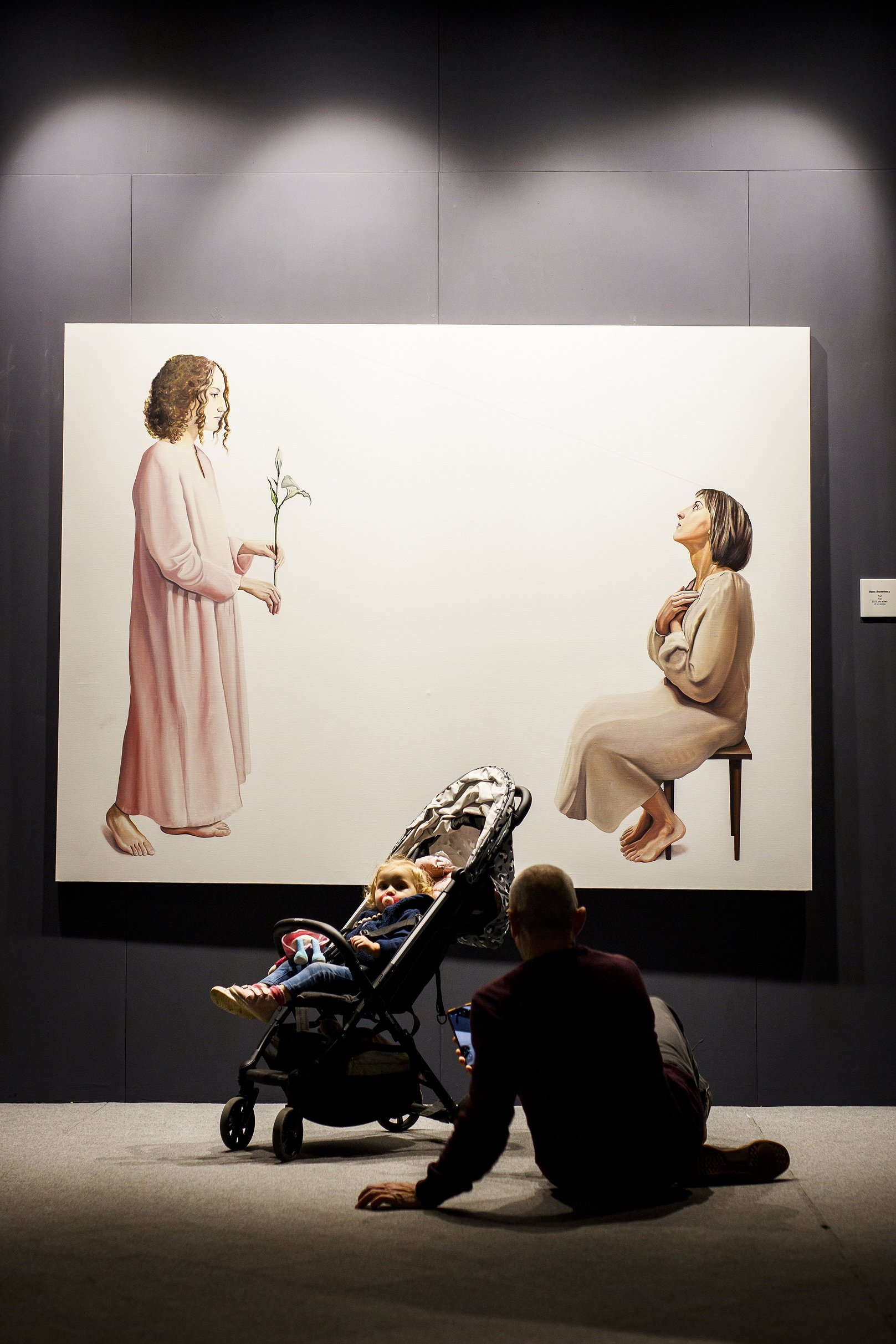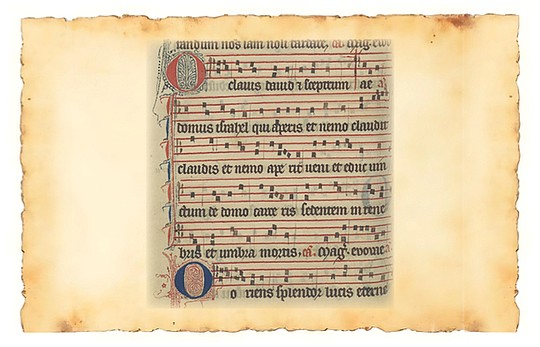Sacred art project aims to revive the 'language of the image' in communicating the faith
July 10, 2024 at 3:29 p.m.

OSV News – For centuries, sacred art has communicated the faith. From ornate stained glass in European cathedrals to the quiet corners of a Catholic family's home, images of key mysteries of the faith help the faithful to understand and embrace the Lord's plan for their own lives.
Dariusz Karlowicz, program director of the St. John Paul II Institute of Culture at the Angelicum in Rome and president of the St. Nicholas Foundation based in Warsaw, is concerned about the lack of new sacred art today that speaks to modern society
Karlowicz and others launched the "Let's Paint Catholicism Again" project in 2022 through the St. John Paul II Institute of Culture and the St. Nicholas Foundation.
"It is a project aiming at a revival of sacred art," he told OSV News. The project brings together "contemporary artists, theologians and Catholic intellectuals to tackle the most important mysteries of the Catholic tradition and translate them into an artistic language understandable in today’s world."
The artists began with paintings of the image of Divine Mercy revealed to St. Faustina Kowalska. Starting last year, they have been painting each of the 20 mysteries of the rosary and recently completed depictions of the Annunciation.
Karlowicz pointed out that when Polish painter Eugeniusz Kazimirowski made the Divine Mercy image following the instruction of St. Faustina, she cried when she saw the image "because it has nothing in common with the beauty she saw" in her vision of Divine Mercy.
"I treat the tears of St. Faustina as a symbol of our effort," he said. When it comes to human effort in depicting the divine "we always fail. Our ambition is to be at least close, that's the whole ambition" of sacred art, adding that when one comes close "it's a certain kind of success, but painful and uncertain – but I strongly believe worth trying."
The project invites a group of nine of the best Polish painters each year and includes a circle of theologians, philosophers and art critics to discuss the question of what sacred art in the Western tradition should be.
Artists currently involved in the project include Jaroslaw Modzelewski, Ignacy Czwartos, Jacek Dluzewski, Wojciech Glogowski, Dominican Father Jacek Hajnos, Krzysztof Klimek, Bogna Podbielska, Beata Stankiewicz, Grzegorz Wnek and Michal Zadlo.
Many of the images created through the project have been purchased by churches in Poland and the group is working in close collaboration with the Diocese of Warszawa-Praga, Poland.
"If we do not make a huge effort for creating a Christian culture, we may wake up one day being completely mute, having no language to communicate the language of the image, of the action, of the stories, of the pictures," Karlowicz said.
He said the project is in response to "a crisis of Christian culture, which I think is a crisis in the fundamental sense of that word. You know that the term crisis comes from medicine, and that's the moment after which it's better or worse. I mean the crisis in medicine, that's that point after which you can die or live, and I think that's the point we are (at) now with Christian culture."
"We may be mute and we may have a treasure which we can't communicate to ourselves," he said, "if we lose language and if we lose culture."
Karlowicz believes that modern culture lacks the images and vocabulary to relate the Gospel message due in part to the secularization of Western culture and religious indifference.
He believes this language of meaningful art in prayer is very important and said he is "afraid of the empty churches" often seen in the U.S. with little or no artistic adornment.
"I think it's a kind of hubris," he said. Sacred art, he explained, is "not only a question of nice decoration. It’s a question of, let's say, fundamental aspects of our faith" and setting them before the eyes of the faithful in prayer.
Regarding his hopes for the project's interpretation of the mysteries of the rosary, Karlowicz said that he "realized for years that praying the rosary, I was thinking about certain pictures from the past. And I hope that in the end of the coming 20 years, I may be praying, thinking about the modern paintings" from this endeavor.
Lauretta Brown is culture editor for OSV News. Follow her on X (formerly Twitter) @LaurettaBrown6.
Related Stories
Saturday, December 13, 2025
E-Editions
Events
OSV News – For centuries, sacred art has communicated the faith. From ornate stained glass in European cathedrals to the quiet corners of a Catholic family's home, images of key mysteries of the faith help the faithful to understand and embrace the Lord's plan for their own lives.
Dariusz Karlowicz, program director of the St. John Paul II Institute of Culture at the Angelicum in Rome and president of the St. Nicholas Foundation based in Warsaw, is concerned about the lack of new sacred art today that speaks to modern society
Karlowicz and others launched the "Let's Paint Catholicism Again" project in 2022 through the St. John Paul II Institute of Culture and the St. Nicholas Foundation.
"It is a project aiming at a revival of sacred art," he told OSV News. The project brings together "contemporary artists, theologians and Catholic intellectuals to tackle the most important mysteries of the Catholic tradition and translate them into an artistic language understandable in today’s world."
The artists began with paintings of the image of Divine Mercy revealed to St. Faustina Kowalska. Starting last year, they have been painting each of the 20 mysteries of the rosary and recently completed depictions of the Annunciation.
Karlowicz pointed out that when Polish painter Eugeniusz Kazimirowski made the Divine Mercy image following the instruction of St. Faustina, she cried when she saw the image "because it has nothing in common with the beauty she saw" in her vision of Divine Mercy.
"I treat the tears of St. Faustina as a symbol of our effort," he said. When it comes to human effort in depicting the divine "we always fail. Our ambition is to be at least close, that's the whole ambition" of sacred art, adding that when one comes close "it's a certain kind of success, but painful and uncertain – but I strongly believe worth trying."
The project invites a group of nine of the best Polish painters each year and includes a circle of theologians, philosophers and art critics to discuss the question of what sacred art in the Western tradition should be.
Artists currently involved in the project include Jaroslaw Modzelewski, Ignacy Czwartos, Jacek Dluzewski, Wojciech Glogowski, Dominican Father Jacek Hajnos, Krzysztof Klimek, Bogna Podbielska, Beata Stankiewicz, Grzegorz Wnek and Michal Zadlo.
Many of the images created through the project have been purchased by churches in Poland and the group is working in close collaboration with the Diocese of Warszawa-Praga, Poland.
"If we do not make a huge effort for creating a Christian culture, we may wake up one day being completely mute, having no language to communicate the language of the image, of the action, of the stories, of the pictures," Karlowicz said.
He said the project is in response to "a crisis of Christian culture, which I think is a crisis in the fundamental sense of that word. You know that the term crisis comes from medicine, and that's the moment after which it's better or worse. I mean the crisis in medicine, that's that point after which you can die or live, and I think that's the point we are (at) now with Christian culture."
"We may be mute and we may have a treasure which we can't communicate to ourselves," he said, "if we lose language and if we lose culture."
Karlowicz believes that modern culture lacks the images and vocabulary to relate the Gospel message due in part to the secularization of Western culture and religious indifference.
He believes this language of meaningful art in prayer is very important and said he is "afraid of the empty churches" often seen in the U.S. with little or no artistic adornment.
"I think it's a kind of hubris," he said. Sacred art, he explained, is "not only a question of nice decoration. It’s a question of, let's say, fundamental aspects of our faith" and setting them before the eyes of the faithful in prayer.
Regarding his hopes for the project's interpretation of the mysteries of the rosary, Karlowicz said that he "realized for years that praying the rosary, I was thinking about certain pictures from the past. And I hope that in the end of the coming 20 years, I may be praying, thinking about the modern paintings" from this endeavor.
Lauretta Brown is culture editor for OSV News. Follow her on X (formerly Twitter) @LaurettaBrown6.











